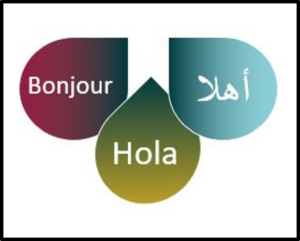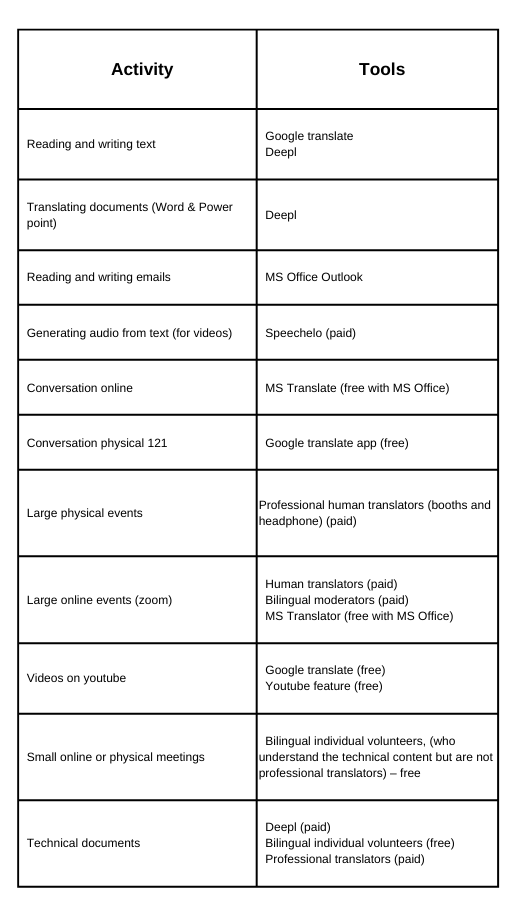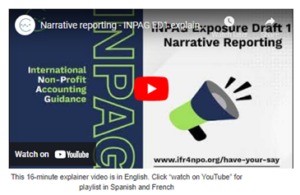What is the IFR4NPO Project?
The IFR4NPO Project is developing internationally applicable financial reporting guidance for Non-Profit Organisations (NPOs). Humentum and the Chartered Institute of Public Finance & Accountancy (CIPFA) are collaborating on this project which will improve the quality and usefulness of year-end audited accounts for NPO credibility & accountability purposes. Some of the specifics of this case study relate to this project and its goals, but hopefully some of the tools and approaches can also be useful in other contexts.
Why is a multi-lingual approach so important?
One of the lasting results of the legacy of colonialism is that much of the power and influence in the world is concentrated in anglophone countries, organisations and individuals. International Accounting Standards in other sectors are written in English, albeit with input in English from stakeholders all over the world.
When it comes to global initiatives, those who speak languages other than English are at a disadvantage in terms of their influence and participation. In order to shift power in the development and humanitarian sectors, meaningful dialogue between people of different languages is essential. In the world of accounting, most of the countries that have developed their own bespoke standards for NPOs are anglophone, (eg UK, USA, Canada, Australia, & New Zealand). Yet the countries which would benefit most from an international standard are in Latin America, Africa & Asia.
Conducting the standard setting process in English only perpetuates the colonial-fueled imbalance of power. Additionally, excluding speakers of languages other than English means important perspectives would be left out of the final product as well as reducing the potential for global uptake.
Which languages?
We focused on languages most widely used among our stakeholders, namely Spanish, French, and Arabic. Unfortunately, we achieved less in Arabic than we hoped – partly because working in French and Spanish required more of a time investment than originally estimated, and partly because the people working on this particular project (non-Arabic speakers) were unable to easily navigate Arabic script and right to left formatting.
Some of the aspects of our communications activities that we looked to engage with multi-lingually, using both one-way and two-way communication, included:


Emails
When receiving an email in a foreign language, Outlook 365 can translate an email you receive. But when replying, we have found it most helpful to use google translate or Deepl and add a copy of the original message in English, and to put your own message in both languages too – this way both parties can read the thread if necessary.
Newsletters
To date, we have only translated our monthly newsletter into Spanish. If using quotes, we try to find quotes from people in Latin America, in Spanish, rather than translating quotes from English; this has the added advantage of broadening the scope of input that we want to share. We also remove any content that is not relevant or contains links to resources that are only available in English. We use Deepl to translate, then get the final version checked by a bilingual volunteer before sending to stakeholders in Latin America.
Glossary
The project frequently uses technical accounting terms that may have specific translations in different languages, and which have already been used in official translations of international accounting standards. It is important that we use the correct term, rather than whichever term the auto-translate may select. For example, the correct term for ‘income’ in French is ‘produits’, not ‘revenue’. We developed a glossary of key terms and uploaded this into Deepl, so that whenever it is translating text it can refer to the glossary. Unfortunately, this glossary feature does not work when translating MS Word or Power Point files. We have become familiar with the common errors that the software makes (e.g. NPO in French is une OBNL (feminine), but the software translates it as un OBNL (masculine), together with any associated adjectives). So we still have to go through the document and make manual corrections, with reference to the glossary. This glossary was generated by the project team together with 3 teams of bilingual technical accountants who volunteered as translation checkers.
Explainer videos
We made a series of four 20-minute explainer videos using MS Power Point slides with audio that cover the technical topics included in our draft guidance. The slides were auto-translated using Deepl, checked by us against the glossary, and checked again by a bilingual volunteer. The audio was scripted in English, and we used Speechelo to generate audio in English. This enabled us to identify needed improvements to the English, to make it sound more natural as spoken language, and to make corrections to the written script before auto-translation.
The auto-translated text was used to generate audio in the new language, again using Speechelo, and the audio file, script and power points were sent to a volunteer translation checker, together with the proposed Youtube video title, description, and Thumbnail. To create the videos, individual audio files generated from Speechelo were added to each slide, and the file was exported as a video mp4 file. This was then uploaded to Youtube.
You can see an example here: https://www.youtube.com/watch?v=mio-We0FhaM
Youtube playlists
We made playlists of all 4 explainer videos in the same language, for use in emails and social posts; see here for an example: https://www.youtube.com/watch?v=KAzzhDrOuXo&list=PLShj6O7GwzSkGKqAjOeP19BV3IzwA3Rbs We also made playlists of the same video in each language, so that the playlist could be embedded in the website.

Real time audio translation
Social media
For social media, we auto-translate and post the same content in each relevant language, ensuring that links refer to the correct language-appropriate content. We then tag key individuals in the non-English posts, who we know will share the posts in their own networks.
Online Q&A
For Q&A during live events, we share the MS Translator app link in the zoom chat and encourage people to share questions in languages other than English in that app.


The producer copies the English equivalent of the question from the Translator App into the zoom chat. The question is answered verbally in English, and is auto-translated by the MS App microphone.
When posting the Q&A video on Youtube, we have included a section on how to activate the auto-translated captioning, for example: https://youtu.be/UhIarJ-S0a8
Country Awareness Events
For events targeted at individuals in non-anglophone countries, we provided the country champions with auto-translated decks and scripts and helped to prepare them to host and deliver the events. Many of our country champions are multi-lingual and this facilitates the correct translation back and forth during the Q&A, or when something went off-script. In any case, we have all had to learn as we go and to be comfortable with losing a bit of control over how the sessions work – but we have found the positives of multi-lingual convening to greatly outweigh any negatives!
Our key take aways?
While we are glad and proud to share our experience in this case study, and have learnt a lot along the way, this is still very much a journey, and we continue to learn. If you have any advice or tips to share, please do!
This article has been reshared by Humentum on its blog and media section.